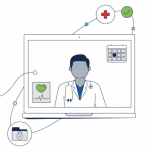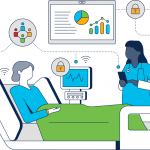It’s an old trope in horror movies: “The call is coming from inside the house!” For healthcare professionals, there’s a similar tale that’s almost as scary — and unfortunately, real.
A recent analysis found that healthcare is the only industry in which insider threats (58%) posed the greatest risk to sensitive data. Yes, the biggest threats could be inside your very walls. Whether by innocent employee user error or intentional snooping (or even hacking), data compromises in healthcare are unacceptable — and could land your organization in a heap of legal and regulatory trouble.
Low-tech remedies like employee training and internal policies are effective, to a point. But to really make a dent in the problem, technology — and more specifically, automation — is the way to go.
It starts with the network.
Traditional networks operate on the idea that a user inside the network is “safe” and can be trusted. But as we’ve just shown, that’s not necessarily the case. A new model, called “zero-trust,” assumes that no part of a network is safer than any other. In zero-trust, you create “whitelists” that allow you to identify specific characteristics of users and devices allowed to access applications and data. In healthcare organizations, this could mean that employees who don’t require patient information and clinical data to do their work are restricted from access.
At this point, you’re thinking, “This all sounds great, but isn’t creating whitelists really time-intensive?”
Yes, you’re right — it is.
Luckily, there’s a way to automate that work. The modern data center can do that, and so much more. Read our white paper, “Putting Data at the Center of Care,” to get the latest thinking on healthcare data centers, including how to best support your critical applications, survive the move to the cloud, and build zero-trust cybersecurity from the inside out.
It turns out, this tale can have a happy ending after all.



CONNECT WITH US